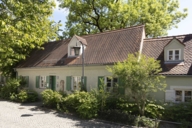
With farms and cobblestones, traditional Bavarian pubs and a Catholic church, Haidhausen’s Preysingstrasse not only looks rustic, but also flaunts a tranquillity and neighbourliness that says: all’s right with the world here!
If you ask locals which street they think is Munich’s most beautiful, they’ll often respond, “Definitely Preysingstrasse.” This small street in Haidhausen has indeed enjoyed particularly good luck over the course of its development: its historic Herbergshäuschen boarding houses survived the War and still tell us about working-class life in the past; an old farmhouse has been restored to its original condition; and then there are the flamboyantly gorgeous cherry trees, which seem to strive to outblossom one another every spring.
This small street was just particularly lucky – the hostel cottages survived the war, an old farmhouse was rebuilt in its original condition.
When you walk along the cobblestones, you almost feel like you're in the countryside. The only thing missing is a mini maypole. But even without it, the street has a lot of village charm: there's the neighbourhood pub Zum Kloster, which has been a popular meeting place for locals for over 40 years. The Preysing Fruchthalle, where you can buy fresh fruit and vegetables just like at the weekly market. Or the small corner café LottiEck, where you can enjoy a leisurely breakfast during the week and forget about the time.
One young woman who has lived on Preysingstrasse for a long time is Claudia Pichler. The cabaret artist grew up in Aubing and could hardly believe her luck when she managed to secure an apartment in the central yet cosy district of Haidhausen. After living in that flat for eight years, she has recently moved – but only a street away, as anyone who gets to live in Haidhausen doesn’t want to leave it. In the village in the middle of Munich, which feels so snug that you are certain all’s right with the world here!
A village in the middle of Munich, which feels so snug that you are certain all’s right with the world here!
We meet Claudia at Zum Kloster; she spends a lot of time at the cosy pub, or on the bench in front of her former apartment building: “Sometimes I still sit here even though I live somewhere else now. I think these benches are a lovely idea – every apartment building should have one.” For her, the most beautiful part of Preysingstrasse is the last part with the play street. When you are walking from Wörthstrasse, it almost looks as though the street ends at the bend, but instead it only becomes really beautiful after that point.
“Preysingstrasse is like the most beautiful version of a village,” she says with conviction. “On the one hand, you have the regular places you like to go and you know the people here – just like in the country – but then when you look more closely, the street looks more like a film set within the village.” The thing Claudia loves best is the evening atmosphere on Preysingstrasse, when there is a particular light and the mood is even more relaxing than it is during the day.
When day labourers used to come to Munich to temporarily work in the city for a while, they would lodge in neighbouring Haidhausen, in one of the quaint little boarding houses known as Herbergshäuschen. Haidhausen was a village near the gates of Munich before it was finally incorporated in 1854. The tiny Üblacker-Häusl was built at the end of the 18th century as one of many Herbergshäuschen here, and in the 1960s it was bought by the city and renovated extensively.
Probably the smallest museum in Munich, it includes a typical living room and bedroom for a day labourer and his family in those days.
Today, it houses the Herbergenmuseum, a museum dedicated to the historic boarding houses that shows visitors how people lived at that time. Probably the smallest museum in Munich, it includes a typical living room and bedroom for a day labourer and his family in those days. The former goat shed now hosts regularly changing exhibitions and events, while the upper floor is still an apartment. The Üblacker-Häusl is a listed building and is one of the last surviving Herbergshäuschen in the district.
Across the road from it is another architectural highlight of Preysingstrasse: the Kriechbaumhof. This Alpine hut is the clubhouse of the German Alpine Club, and it looks back on a rather unusual history. The building was originally constructed in the 17th century, on Wolfgangstrasse in Haidhausen; after falling into disrepair, it was removed piece-by-piece and rebuilt on Preysingstrasse in 1985.
These types of wooden houses were still very common in the working-class districts of Haidhausen and the Au before the War. Here too, day labourers could rent a room or an entire floor on a temporary basis. Today the Kriechbaumhof’s unique architecture makes it stand out; there is no other building in Munich that looks like it. With its largely wooden structure and colourfully planted balconies, the building is reminiscent of a farmhouse in the Alps – so it is very fitting indeed that the younger members of the German Alpine Club meet here.